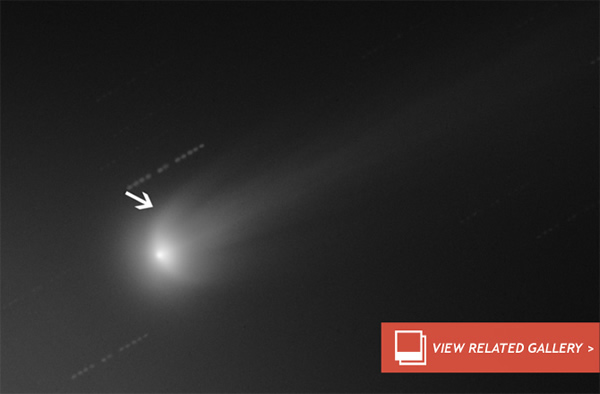Chunks of Ice May Have Broken Off Comet ISON
Although Comet ISON appears to be holding its own against the increasing solar heat as it continues its risky game of “chicken” with the sun, the large mass of ice isn’t getting away unscathed — new observations show evidence for one or more large icy chunks breaking away from ISON’s nucleus.
Earlier this month, the potential “Comet of the Century” underwent a rapid brightening event, likely caused large fissures of ice suddenly sublimating and blasting gas into space. The resulting increase of gas contained within the comet’s coma and tail reflected more light from the sun, causing it to brighten and become a naked-eye object. Although ISON could be spotted for a few days just before dawn, its light is quickly becoming overwhelmed by sunlight as it approaches perihelion (solar close approach).
On Nov. 28, ISON will arrive at its closest point, just 1.2 million miles (1.9 million kilometers) from the sun’s photosphere deep within the multimillion degree corona (the sun’s atmosphere). The sungrazing comet, which is making its first inner solar system orbit, may survive the ordeal, reappearing from the far side of the sun intact, ready to give Earth a beautiful light show in December. But it could also break apart, succumbing to the intense solar energy.
Though its structure appears to be holding out, there are some signs that chunks of the comet have already started to peel off, exposing ISON’s pristine ices to the sun’s wrath.
During observations on Nov. 14 and 16, astronomers of the Wendelstein Observatory (in the Bavarian Alps) and the Max Planck Institute for Solar System Research studied “wings” that had appeared in ISON’s tail that may be related to the comet’s recent outburst.
“Such structures typically occur after individual fragments have split off from the nucleus of a comet,” said Hermann Böhnhardt, of the Max Planck Institute.
Although Böhnhardt points out the evidence is currently circumstantial, wing-like structures in comet tails are a well-known phenomena. As pieces of ice fall away into space, the sublimating ices in the main cometary mass collide with the obstruction in the tail, diverting. A “separation layer” in the comet tail forms, creating the wings.
If ISON has started shedding some of its mass, “past experience has shown that comets which have lost fragments once have a tendency to do so again,” said Böhnhardt. But even now, with only six days before perihelion, few astronomers will be betting with any certainty on Comet ISON’s final act.
Image: The comet is centre stage: this image shows the gaseous environment of comet ISON with two wing-like structures which look like an elongated U (arrow). The nucleus is shown as a bright spot in the centre for orientation. Credit: Wendelstein Observatory/MPS(Nov 22, 2013 08:43 PM ET // by Ian O'Neill)












